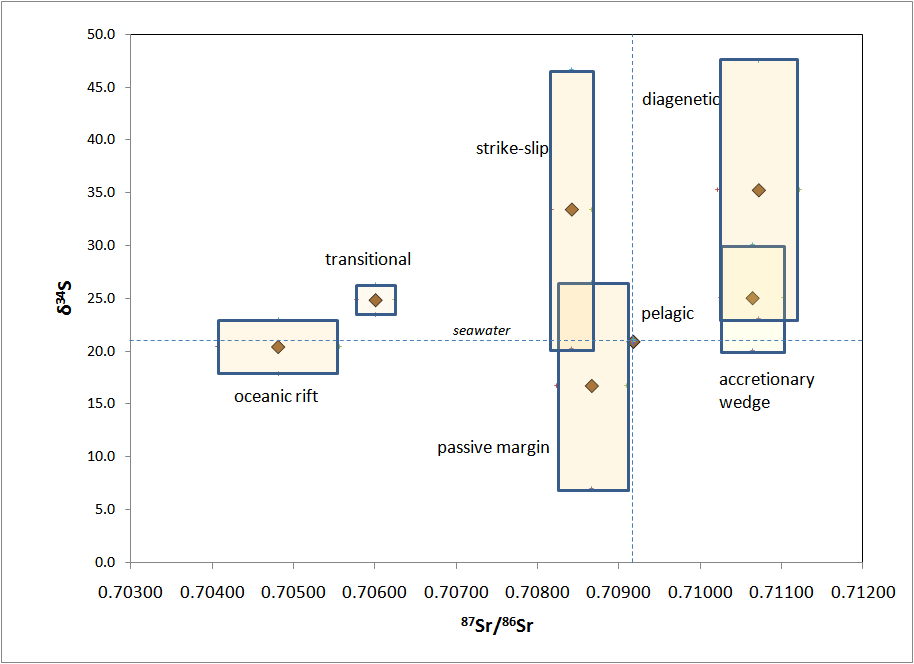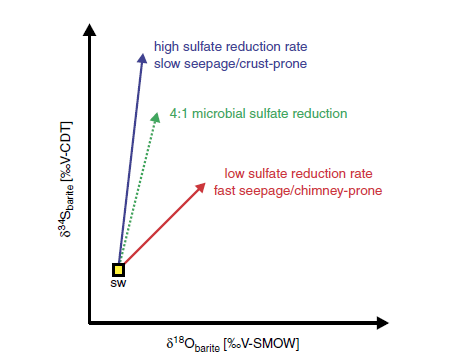Isotope systems in modern barite deposits
The mineral barite is very insoluble under most conditions except where the oxidation state is very low and sulfate-reducing bacteria are active. Therefore, once formed, barite has little tendency to exchange isotopes with its surroundings. It also carries three separate isotope systems: oxygen, strontium, and sulfur. Because the mineral does not incorporate rubidium, strontium can be treated as a stable isotope, just like the other two. There are commonly small amounts of calcium incorporated in the structure and it is possible to measure calcium isotopes, but there is as yet little data on this system.
A survey of the available data shows considerable variability among types of barites (see Modern Barite Occurrences for more details).
Average isotopic composition of barite from various tectonic settings |
|||||||
Sample |
n |
87Sr/86Sr | Δ87Sr/86Sr | δ34S sulfate | Δδ34S sulfate | δ18O smow | 44Ca/40 Ca |
| Hydrothermal deposits | |||||||
| Oceanic rifts | 34 |
0.70481 |
-0.00436 |
20.45 |
0.2 |
7.23 |
-3.52 |
| Transitional rifts | 5 |
0.70601 |
-0.00316 |
24.88 |
4.6 |
-2.74 |
|
| Continental rifts | 0 |
||||||
| Cold seeps | |||||||
| Accretionary prism | 9 |
0.71064 |
0.00147 |
25.07 |
4.8 |
14.67 |
|
| Strike-slip basins | 23 |
0.70842 |
-0.00075 |
33.46 |
13.2 |
-3.02 |
|
| Passive margin delta | 32 |
.70868 |
-0.00051 |
32.2 |
-3.5 |
12.7 |
|
| Diagenetic | |||||||
| Nodules at Reaction fronts | 5 |
0.71072 |
.00155 |
35.28 |
15 |
||
| Authigenic | |||||||
| Pelagic barite | 55 |
0.70918 |
0.00001 |
20.93 |
0.6 |
||
Sources: Paytan et al. 2002 and references therein; Torres et al. 2002, Griffith et al. 2008, Hein et al. 2007, Feng and Roberts, 2011. Δ sample - seawater; n is the number of analyses (most do not include all 4 isotopes) |
|||||||
Does this variability provide a means of identifying types of deposits in the ancient? If we compare the range of variation in S and Sr in modern barites, as shown in the figure below, we see that some types of deposits are distinctive (e.g. oceanic rifts), but that the others show some overlap. We can conclude that Sr does provide some information about tectonic setting, although often there are two possible interpretations. S, on the other hand, can provide information about depositional processes.

Oxygen is not as well understood, but holds promise for understanding fluid behavior during deposition, as shown in the following figure from Feng and Roberts, 2011.

Ore Deposits Home |
Barite references |
Site Map |
|---|